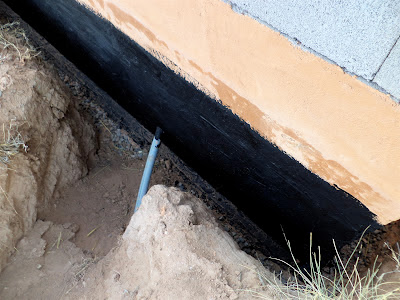This is the second post on our well house project
and in the first post, Building A Well House #1: Rubble Fill Foundation,
we looked at the foundation and got up to the first course of block.
Above we have dry stacked the block
and prepared the form for a 4" bond beam at the midsection
at which time we will also fill all the cores in the block up to that point.
This mid section bond beam is a bit of overkill
but I needed to size the footer forms to the bond beam dimensions anyway,
and the forms make it easier to fill the cement block cores with concrete
much like a funnel.
The forms are the same ones we used for the 12" wide footer
and of course had to be resized to fit the 5 5/8"bond beam (the actual width of 6" block);
the outside forms needed to be cut down
and the inside forms needed to be lengthened.
Everything is screwed together
so that reconfiguring and eventual disassembly is pretty easy.
The white pipe in the wall (above) is a spacer for conduit for an outside receptacle
and is removed after the concrete sets up.
Tie wire is used to hold the forms together
and as you can see above is twisted to pull the forms together tight.
Nails twisted into the tie wire
are used on the outside of the forms to hold everything together
but be sure you have a method to remove the nails after the pour
as the weight of the concrete and the swelling of the wet forms
can embed the nails into the wooden forms making them very hard to remove;
I like to have a twist of the tie wire (not just a loop) on each side
so that pliers can easily untwist when it is time to remove the forms.
Both the vertical and the horizontal 1/2" rebar are tied together,
which creates a bit of tension in the metal
increasing the strength of the resulting concrete.
The spacer blocks are pulled out as the pour progresses.
First we filled the cores in the block with concrete
and then came back and topped off the 4" bond beam.
As I described in the last post, just as the concrete bond beam starts to set up
we set the next course of block so that they bond to the bond beam
and then filled the cores about half way up.
Above the forms have been removed and the surface bonding cement
(the brownish orange color and our only choice) applied
so that we can back fill between the bank and the wall.
Surface bonding cement is a cement based bond for block walls,
applied with a trowel much like stucco,
that has added fiber and possibly some latex or acrylic additives
and is an amazing product first introduced about 30 years ago.
It is actually stronger than a conventionally laid mortared block wall
and for the owner builder allows more time
to carefully set a block wall straight and plumb.
Since I always fill the cores of the block with concrete
it is always a question whether to fill the cores first
or apply the surface bonding cement first;
I generally go with the former.
Inside we can see the bond beam as well as a couple of small sections between blocks
that we decided to fill with concrete instead of cut block.
As we wait for things to dry...
...so we can water proof below grade, we have started our next course
(note the masons string line to get things straight).
The surface bonding cement is water resistant
and we also applied emulsified asphalt (water based instead of solvent based)
below grade.
Because of our dry climate and the fact that our wall
really doesn't need to be completely water proof this should be adequate
but in areas with below grade moisture problems another approach may be needed.
The grey PVC pipe is the electrical conduit from the well.
After everything dries we will add the 2" XPS rigid foam insulation,
a couple more inches of gravel and then back fill.
In wetter climates perforated pipe around the bottom of the foundation
to drain off ground water away from the building may be advised.
Next post we will finish the block wall.
Please note that the tips and techniques I show here assume
that the reader has some minimum building skills
or are used as an addition to another source of expertise
such as a training program, textbook, etc.
This is not intended as a sole source of information.
Here is a list of the entire series to date:











